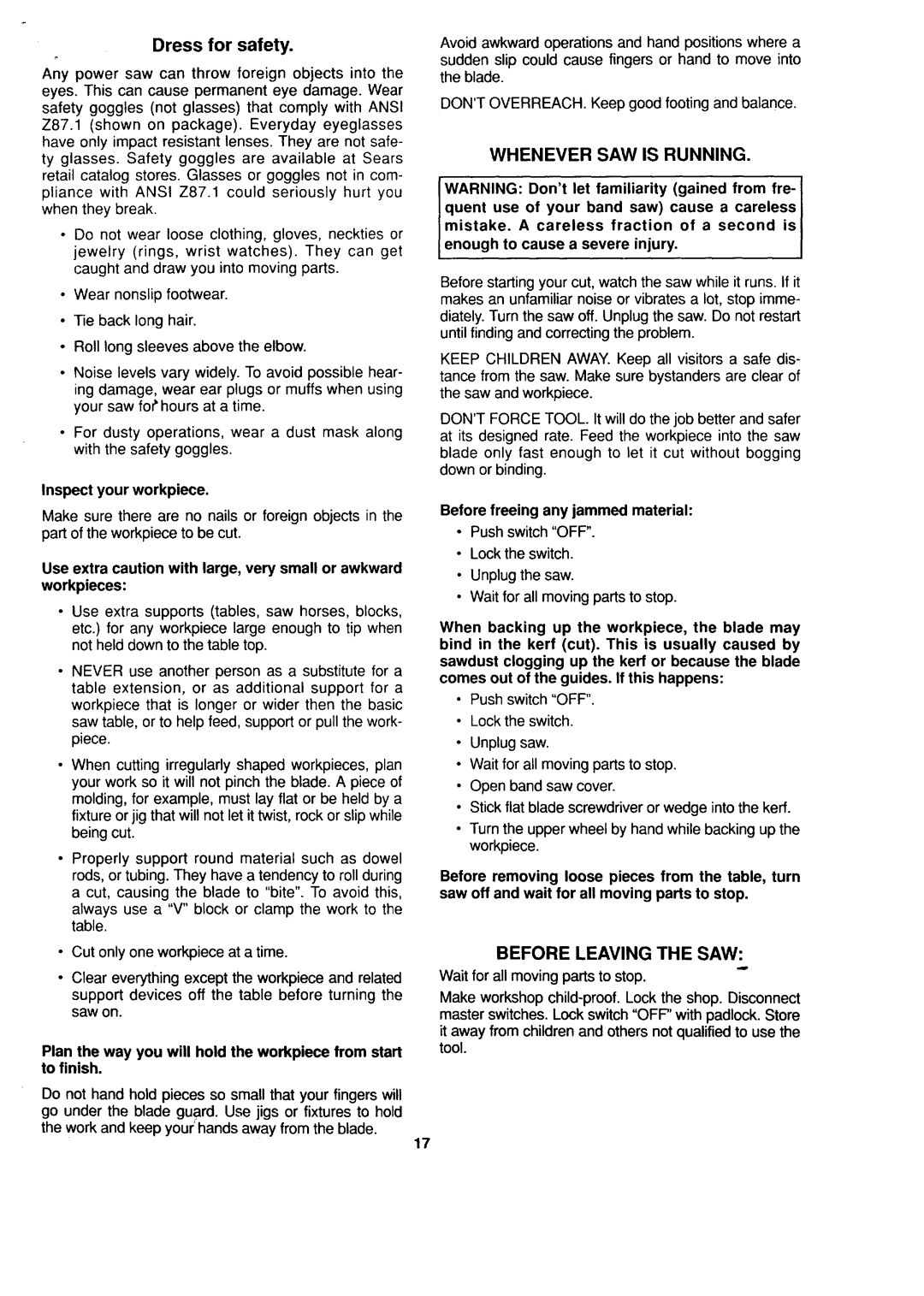
Dress for safety.
Any power saw can throw foreign objects into the eyes. This can cause permanent eye damage. Wear safety goggles (not glasses) that comply with ANSI Z87.1 (shown on package). Everyday eyeglasses have only impact resistant lenses. They are not safe- ty glasses. Safety goggles are available at Sears retail catalog stores. Glasses or goggles not in com- pliance with ANSI Z87.1 could seriously hurt you when they break.
•Do not wear loose clothing, gloves, neckties or jewelry (rings, wrist watches). They can get caught and draw you into moving parts.
•Wear nonslip footwear.
•Tie back long hair.
•Roll long sleeves above the elbow.
•Noise levels vary widely. To avoid possible hear- ing damage, wear ear plugs or muffs when using your saw foe hours at a time.
•For dusty operations, wear a dust mask along with the safety goggles.
Inspect your workpiece.
Make sure there are no nails or foreign objects in the part of the workpiece to be cut.
Use extra caution with large, very small or awkward workpieces:
•Use extra supports (tables, saw horses, blocks, etc.) for any workpiece large enough to tip when not held down to the table top.
•NEVER use another person as a substitute for a table extension, or as additional support for a workpiece that is longer or wider then the basic saw table, or to help feed, support or pull the work- piece.
•When cutting irregularly shaped workpieces, plan your work so it will not pinch the blade. A piece of molding, for example, must lay flat or be held by a fixture or jig that will not let it twist, rock or slip while being cut.
•Properly support round material such as dowel rods, or tubing. They have a tendency to roll during a cut, causing the blade to "bite". To avoid this, always use a "V" block or clamp the work to the table.
•Cut only one workpiece at a time.
•Clear everything except the workpiece and related
support devices off the table before turning the
saw on.
Plan the way you will hold the workpiece from start to finish.
Do not hand hold pieces so small that your fingers will go under the blade guard. Use jigs or fixtures to hold the work and keep your'hands away from the blade.
Avoid awkward operations and hand positions where a sudden slip could cause fingers or hand to move into the blade.
DON'TOVERREACH. Keep good footing and balance.
WHENEVER SAW IS RUNNING.
WARNING: Don't let familiarity (gained from fre- quent use of your band saw) cause a careless mistake. A careless fraction of a second is
enough to cause a severe injury.
Before starting your cut, watch the saw while it runs. If it makes an unfamiliar noise or vibrates a lot, stop imme- diately. Turn the saw off. Unplug the saw. Do not restart until finding and correcting the problem.
KEEP CHILDREN AWAY. Keep all visitors a safe dis- tance from the saw. Make sure bystanders are clear of the saw and workpiece.
DON'TFORCE TOOL. It will do the job better and safer at its designed rate. Feed the workpiece into the saw blade only fast enough to let it cut without bogging down or binding.
Before freeing any jammed material:
•Push switch "OFF".
•Lock the switch.
•Unplug the saw.
•Wait for all moving parts to stop.
When backing up the workpiece, the blade may bind in the kerf (cut). This is usually caused by sawdust clogging up the kerf or because the blade comes out of the guides. If this happens:
•Push switch "OFF".
•Lock the switch.
•Unplug saw.
•Wait for all moving parts to stop.
•Open band saw cover.
•Stick flat blade screwdriver or wedge into the kerf.
•Turn the upper wheel by hand while backing up the workpiece.
Before removing loose pieces from the table, turn saw off and wait for all moving parts to stop.
BEFORE LEAVING THE SAW:
Wait for all moving parts to stop.
Make workshop
master switches. Lock switch "OFF" with padlock. Store it away from children and others not qualified to use the tool.
17
